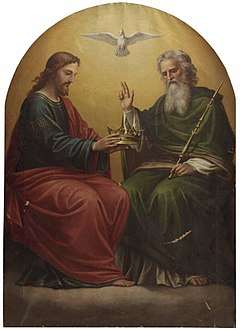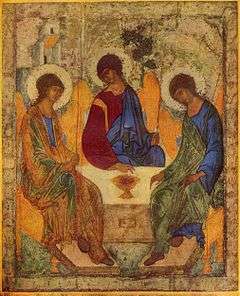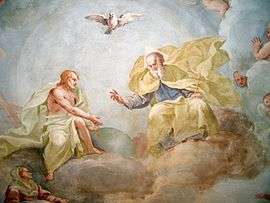Trinity Sunday
Trinity Sunday is the first Sunday after Pentecost in the Western Christian liturgical calendar, and the Sunday of Pentecost in Eastern Christianity.[2] Trinity Sunday celebrates the Christian doctrine of the Trinity, the three Persons of God: the Father, the Son, and the Holy Spirit.[3]
| Trinity Sunday | |
|---|---|
 The Blessed Trinity with Crown, oil on panel, Max Fürst (1846–1917)) | |
| Observed by | Western Christianity |
| Type | Christianity |
| Date | The Sunday after Pentecost |
| 2019 date |
|
| 2020 date |
|
| 2021 date |
|
| 2022 date |
|
| Frequency | yearly |
| Related to | Pentecost Corpus Christi |
Western Christianity
Trinity Sunday is celebrated in all the Western liturgical churches: Latin Catholic, Anglican,[4] Lutheran,[5] Presbyterian,[6] United Church of Christ,[7] and Methodist.[8]
Church year
"Ordinary Time, meaning ordered or numbered time, is celebrated in two segments: from the Monday following the Baptism of Our Lord up to Ash Wednesday; and from Pentecost Monday to the First Sunday of Advent."[9] Sundays and weeks of the liturgical year are numbered continuously from the beginning of Ordinary Time.[10] This makes it the largest season of the Liturgical Year. In the revised Roman rite, Ordinary Time resumes one week earlier, on the Monday after Pentecost, with the Sundays that would otherwise fall on Pentecost and Trinity Sunday omitted that year. In the Church of England, following the pre-Reformation Sarum use, the following Sunday is the "First Sunday after Trinity", while the Episcopal Church in the United States of America (ECUSA)[11] now follows the Catholic usage, calling it the Second Sunday after Pentecost. The liturgical colour used on Trinity Sunday is white.[10]
Catholicism
In the Catholic Church it is officially known as the Solemnity of the Most Holy Trinity. Prior to the reforms of the Second Vatican Council, it marked the end of a three-week period when church weddings were forbidden. The period began on Rogation Sunday, the fifth Sunday after Easter. Trinity Sunday was established as a Double of the Second Class by Pope John XXII to celebrate the Trinity.[12] It was raised to the dignity of a Double of the First Class by Pope Pius X on 24 July 1911. During the Middle Ages, especially during the Carolingian period, devotion to the Blessed Trinity was a highly important feature of private devotion and inspired several liturgical expressions.[13] The currently prescribed liturgical color is white.[10]
In the traditional Divine Office, the Athanasian Creed (Quicumque vult) is said on this day at Prime. Before 1960, it was said on all Sundays after Epiphany and Pentecost which do not fall within Octaves or on which a feast of Double rank or higher was celebrated or commemorated, as well as on Trinity Sunday. The 1960 reforms reduced it to once a year, on this Sunday.
In the 1962 Missal, the Mass for the First Sunday After Pentecost is not said or commemorated on Sunday (it is permanently impeded there by Trinity Sunday), but is used during the week if the ferial Mass is being said.[10]
The Thursday after Trinity Sunday is observed as the Feast of Corpus Christi. In some countries, including the United States,[10] Canada, and Spain, it may be celebrated on the following Sunday, when the faithful are more likely to attend Mass and be able to celebrate the feast.
Anglicanism
The Athanasian Creed, although not often used, is recited in certain Anglican churches, particularly those of High Church tendency. Its use is prescribed in the 1662 Book of Common Prayer of the Church of England for use on certain Sundays at Morning Prayer, including Trinity Sunday, and it is found in many modern Anglican prayer books. It is in the Historical Documents section of the 1979 Book of Common Prayer (Episcopal Church), but its use is not specifically provided for in the rubrics of that prayer book.
Trinity Sunday has the status of a Principal Feast in the Church of England and is one of seven principal feast days in the Episcopal Church (United States).
Thomas Becket (1118–70) was consecrated Archbishop of Canterbury on the Sunday after Pentecost (Whitsun), and his first act was to ordain that the day of his consecration should be held as a new festival in honour of the Holy Trinity. This observance spread from Canterbury throughout the whole of western Christendom.
Anglican parishes with an Anglo-Catholic churchmanship observe Corpus Christi on the following Thursday, or in some cases the following Sunday.
Methodism
In traditional Methodist usage, The Book of Worship for Church and Home (1965) provides the following Collects for Trinity Sunday:[14]
Almighty and everlasting God, who hast given unto us thy servants grace, by the confession of a true faith, to acknowledge the glory of the eternal Trinity, and in the power of the divine majesty to worship the unity: We beseech thee to keep us steadfast in this faith and evermore defend us from all adversities who livest and reignest, one God, world without end. Amen.[14]
Almighty and everlasting God, who hast revealed thyself as Father, Son, and Holy Spirit, and dost ever live and reign in the perfect unity of love: Grant that we may always hold firmly and joyfully to this faith, and, living in praise of thy divine majesty, may finally be one in thee; who art three persons in one God, world without end. Amen.[14]
Dates
Trinity Sunday is the Sunday following Pentecost, and eight weeks after Easter Sunday. The earliest possible date is May 17 (as in 1818 and 2285). The latest possible date is June 20 (as in 1943 and 2038).
- 2016: May 22 (Western)
- June 19 (Eastern)
- 2017: June 11 (Western)
- June 4 (Eastern)
- 2018: May 27 (Western)
- May 27 (Eastern)
- 2019: June 16 (Western)
- June 16 (Eastern)
- 2020: June 7 (Western)
- June 7 (Eastern)
- 2021: May 30 (Western)
- June 20 (Eastern)
- 2022: June 12 (Western)
- June 12 (Eastern)
- 2023: June 4 (Western)
- June 4 (Eastern)
History
In the early Church, no special Office or day was assigned for the Holy Trinity. When the Arian heresy was spreading, the Fathers prepared an Office with canticles, responses, a Preface, and hymns, to be recited on Sundays. In the Sacramentary of St. Gregory the Great (P.L., LXXVIII, 116) there are prayers and the Preface of the Trinity. The Micrologies (P.L., CLI, 1020), written during the pontificate of Gregory VII (Nilles, II, 460), call the Sunday after Pentecost a Dominica vacans, with no special Office, but add that in some places they recited the Office of the Holy Trinity composed by Bishop Stephen of Liège (903-20). By others the Office was said on the Sunday before Advent. Alexander II (1061–1073), refused a petition for a special feast on the plea, that such a feast was not customary in the Roman Church which daily honoured the Holy Trinity by the Gloria Patri, etc., but he did not forbid the celebration where it already existed. John XXII (1316–1334) ordered the feast for the entire Church on the first Sunday after Pentecost. A new Office had been made by the Franciscan John Peckham, Canon of Lyons, later Archbishop of Canterbury (d. 1292). The feast ranked as a double of the second class but was raised to the dignity of a primary of the first class, 24 July 1911, by Pius X (Acta Ap. Sedis, III, 351). Since it was after the first great Pentecost that the doctrine of the Trinity was proclaimed to the world, the feast becomingly follows that of Pentecost.
Eastern Christianity

In the Eastern Orthodox and Eastern Catholic churches, the Sunday of Pentecost itself is called Trinity Sunday (the Sunday after Pentecost is All Saints Sunday). The Monday after Pentecost is called Monday of the Holy Spirit, and the next day is called the Third Day of the Trinity. Though liturgical colours are not as fixed in the Eastern practice (normally there are simply "festive" colours and "somber" or Lenten colours), in some churches, green is used for Pentecost and its Afterfeast.
Bach cantatas
Johann Sebastian Bach composed a number of cantatas for Trinity Sunday. Three of them are extant, including O heilges Geist- und Wasserbad, BWV 165, Es ist ein trotzig und verzagt Ding, BWV 176, and Gelobet sei der Herr, mein Gott, BWV 129. The cantata Höchsterwünschtes Freudenfest, BWV 194, composed for dedication of the church and organ at Störmthal, was performed again in Leipzig for Trinity Sunday, first on 4 June 1724, a shortened version in 1726, and the complete version in 1731.
References
- Selected Christian Observances, 2020, U.S. Naval Observatory Astronomical Applications Department
- "Christianity: The Trinity". BBC. BBC. Retrieved 2016-05-20.
- Anniversaries and holidays by Bernard Trawicky, Ruth Wilhelme Gregory 2000 ISBN 0-8389-0695-8 page 225
- "Trinity Sunday in the United Kingdom". www.timeanddate.com. Retrieved 2019-11-30.
- "Questions and answers about Trinity Sunday", St. Paul's Lutheran Church, Kingsville Archived 2013-06-17 at the Wayback Machine
- "Trinity Sunday | The Christian Year". Presbyterian Mission Agency. Retrieved 2019-11-30.
- "Trinity Sunday", UCC Worship Ways,
- "Trinity Sunday/First Sunday after Pentecost". United Methodist Church Discipleship Ministries. Retrieved 17 March 2016.
- "Library : Ordinary Time Workshop". www.catholicculture.org. Retrieved 2019-11-30.
- "Liturgical Calendar". www.usccb.org. Retrieved 2019-11-30.
- "Trinity Sunday". www.lectionarypage.net. Retrieved 2019-11-30.
- "CATHOLIC ENCYCLOPEDIA: Trinity Sunday". www.newadvent.org. Retrieved 2019-11-30.
- "Library : Directory on Popular Piety and the Liturgy: Principles and Guidelines". www.catholicculture.org. Retrieved 2019-11-30.
- The Book of Worship for Church and Home: With Orders of Worship, Services for the Administration of the Sacraments and Other Aids to Worship According to the Usages of the Methodist Church. Methodist Publishing House. 1964. p. 131. Retrieved 25 March 2017.
External links
| Wikisource has the text of the 1911 Encyclopædia Britannica article Trinity Sunday. |

